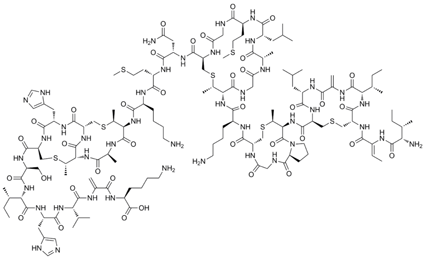BionatFP BionatFP NS25 (Nisin) :Natural Food Preservative
Seebio Natural Food Preservative: BionatFP NS25 (Nisin)
| Name: |
BionatFP NS25 (Nisin) |
|
CASN: |
1414-45-5 |
|
EINECS: |
215-807-5 |
|
Molecular formula: |
C143H230N42O37S7 |
|
Molar mass: |
3354.07 g/mol |
|
Appearance: |
powder |
|
Density: |
1.402 g/mL |
|
Formula: |
|
Description and Properties
Nisin is a polycyclic antibacterial peptide with 34 amino acid residues. It contains the uncommon amino acids lanthionine (Lan), methyllanthionine (MeLan), didehydroalanine (Dha) and didehydroaminobutyric acid (Dhb). These unusual amino acids are introduced by posttranslational modification of the precursor peptide. In these reactions a ribosomally synthesized 57-mer is converted to the final peptide. The unsaturated amino acids originate from serine and threonine, and the enzyme-catalysed addition of cysteine residues to the didehydro amino acids result in the multiple (5) thioether bridges.
Nisin is produced by fermentation using the bacterium Lactococcus lactis. Commercially, it is obtained from the culturing of Lactoccus lactis on natural substrates, such as milk or dextrose, and is not chemically synthesized.
While most bacteriocins generally inhibit only closely related species, Nisin is a rare example of a "broad-spectrum" bacteriocin effective against many Gram-positive organisms, including lactic acid bacteria, Listeria monocytogenes, Staphylococcus aureus, Bacillus cereus, Clostridium botulinum, etc. It is also particularly effective against spores. Gram-negative bacteria are protected by their outer membrane but may become susceptible to nisin action after a heat shock or when this is coupled with the chelator EDTA. Nisin is soluble in water and can be effective at levels nearing the parts per billion range.
Applications
The suitability of nisin as a food preservative arises from the following characteristics: it is non-toxic, the producer strains of L. lactis are regarded as safe (food-grade); it is not used clinically; there is no apparent cross-resistance in bacteria that may effect antibiotic therapeutics; and it is quickly digested. In 1969, nisin was approved for use as an antimicrobial in food by the Joint FAO/WHO Expert Committee on Food Additives. Since then nisin has been given the food additive number E234 and is permitted currently for use in over 50 countries.
Nisin was first introduced commercially as a food preservative in the UK approximately 30 years ago. First established use was as a preservative in processed cheese products and since then numerous other applications in foods and beverages have been identified. It is currently recognized as a safe food preservative in approximately 50 countries. The established uses of nisin as a preservative in processed cheese, various pasteurised dairy products, and canned vegetables will be briefly reviewed. More recent applications of nisin include its use as a preservative in high moisture, hot baked flour products (crumpets) and pasteurised liquid egg. Renewed interest is evident in the use of nisin in natural cheese production. Considerable research has been carried out on the antilisterial properties of nisin in foods and a number of applications have been proposed. Uses of nisin to control spoilage lactic acid bacteria have been identified in beer, wine, alcohol production and low pH foods such as salad dressings.
Further developments of nisin are likely to include synergistic action of nisin with chelators and other bacteriocins, and its use as an adjunct in novel food processing technology such as higher pressure sterilisation and electroporation. Production of highly purified nisin preparations and enhancement by chelators has led to interest in the use of nisin for human ulcer therapy, and mastitis control in cattle.
Due to its naturally selective spectrum of activity, it is also employed as a selective agent in microbiological media for the isolation of gram-negative bacteria, yeast, and moulds. In combination with miconazole it has been studied as a possible treatment for C.difficile infections. Ongoing research seems to indicate that nisin may also have potential for slowing down the growth of certain tumors.
Use Method
Nisin is used in processed cheese, meats, beverages, etc. during production to extend shelf life by suppressing Gram-positive spoilage and pathogenic bacteria. It is common to use Nisin in foods at levels ranging from ~1-25ppm, depending on the type and regulatory approval. In Australia and New Zealand it is allowed in cream products (flavoured, whipped, thickened, and sour cream) at a maximum of 10 mg/kg; in crumpets, flapjacks and pikelets (hot plate flour products) at a maximum of 250 mg/kg; and in cheese and cheese products, oil emulsions (<80% oil), tomato products pH 4.5, beer and related products, liquid egg products, dairy and fat based desserts, dips and snacks, sauces, toppings, mayonnaises and salad dressings at levels compliant with good manufacturing practice.
Order Information
| Catalog# |
Name |
Grade |
Pack Size |
Storage |
|
BionatFP NS25 (Nisin) |
≥2.5% |
250mg |
4-15℃. Stored in well-closed container. |
Seebio Natural Food Preservative: BionatFP BionatFP NS25 (Nisin)
Seebio Natural Food Preservative: BionatFP LZM95 (Lysozyme)
Seebio Natural Food Preservative: BionatFP PT90 (Natamycin)
Seebio Natural Food Preservative: BionatFP NA98 (Protamine)
Seebio Biotech(Shanghai) Co., Ltd.
11-502. Lane 299, Bisheng Rd.
Zhangjiang High Tech Park
Shanghai 201204, P.R.China
Tel: 86-21-50272975, 76, 77, 78, 79, 81; Ext:6513, 6515, 6516, 6520, 6521, 6522
For customers' complaint or suggestion: market5@seebio.cn
Web: www.seebio.cn
Email: fyland@seebio.cn; foodadd@seebio.cn
MSN:seebio8@hotmail.com
Skype:seebiocn

